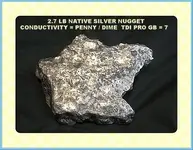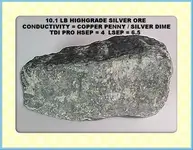Jim, so what your saying is the GPX can locate a nugget in tightly packed ground over loosely pack ground?
Hi AZ… geez I hadn’t thought of it that way, so no that is not the point I was making above. I don’t know if that is true or not… it’s not something I think about… maybe Reg could supply a technical answer if he happens to see this.
What I was thinking is that when a hole is dug and a test target is buried the soil has been disturbed. Digging and refilling a hole creates a localized soil anomaly. Perhaps it results from the disruption of the soil’s electrical continuity, the soil’s magnetic fraction, or whatever other factors may be involved… your guess is as good as mine.
But in my experience with my units here AZ, a freshly buried test target will not respond with the same signal strength as can be expected from an identical target that has naturally settled or occurs in undisturbed ground at the same depth. Nor will such test targets target ID on a VLF nearly as well as can be had with undisturbed targets at the same depth in the park down the road. Same soil type… but undisturbed ground.
I have read that some European detectors are very good in disturbed ground with respect to depth AND target ID. It leads me to speculate that at least in part it depends on how signals are processed… but beyond that I can’t comment.
This past autumn in silver country, I experienced a far more extreme example. I got a decent high-low signal with my Infinium and dug. I can’t say how deep the small ore sample actually was… anywhere between one and six inches. I dug a decent little hole but no sign of a target… normally I can spot them. Rechecking the hole produced no signal. Checking my dirt pile produced no signal. I then swept the dirt pile with my Propointer and got a signal from a coin-size silver ‘stringer’ type ore. And that was the source of the signal because there was no signal remaining in the hole.
Some might speculate it was a so-called halo effect that allowed that piece to signal, and once the halo was removed, no signal. I don’t subscribe to that theory because… except for rusting ferrous targets… I don’t believe the residues leached from non-ferrous targets are sufficient to support signal producing eddy currents to a sensitive VLF let alone a PI unit. There are other theories that attempt to explain such occurrences, but I don’t know that any are accepted as fully adequate explanations.
I prefer to assign responsibility for such oddities to “disturbed ground effect” whatever the heck that fully comprises… and get on with detecting. In this example however, that silver ore would also not give an air test signal when swept very closely across the Infinium’s 8” round mono coil.
Jim.






